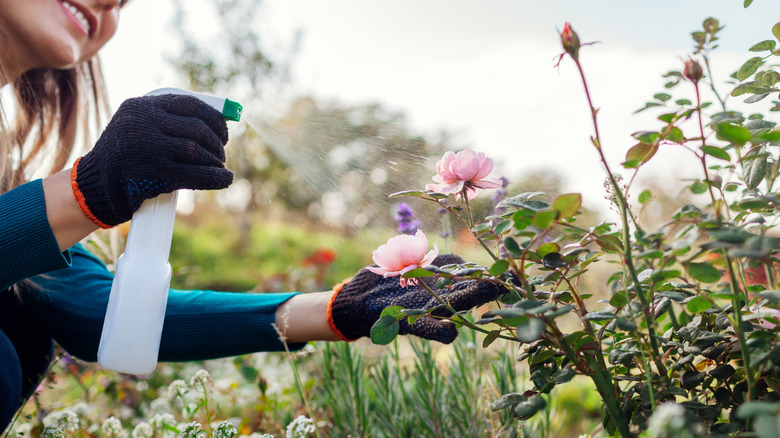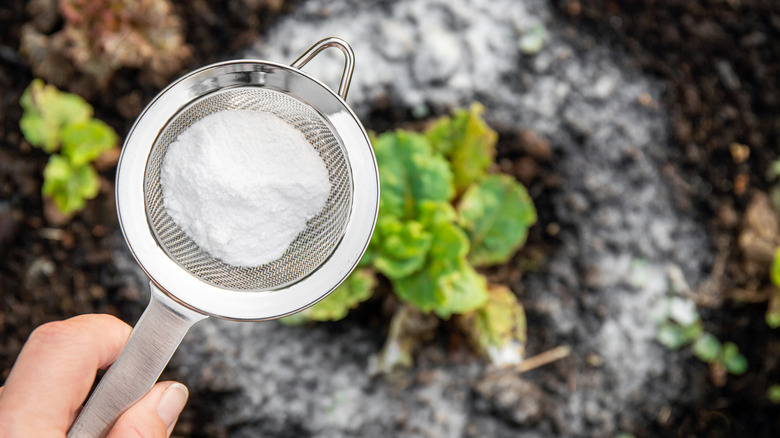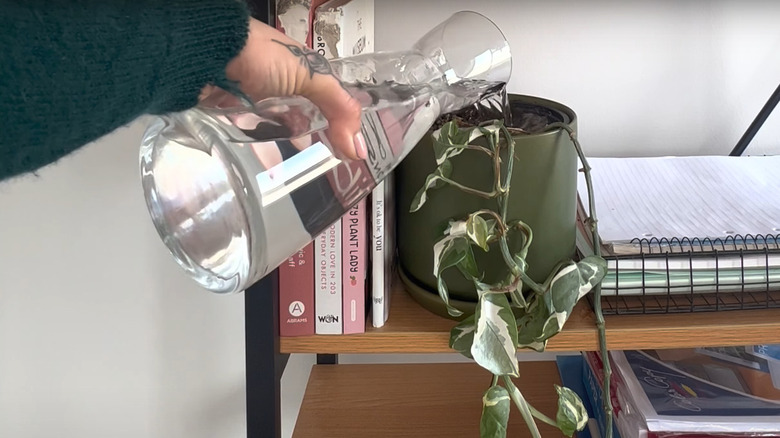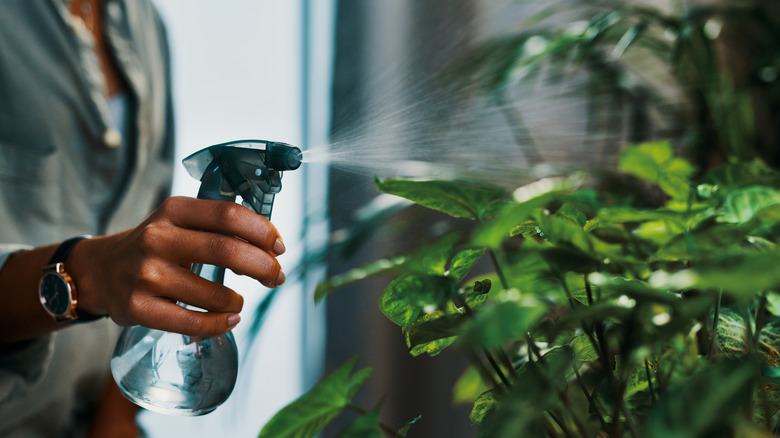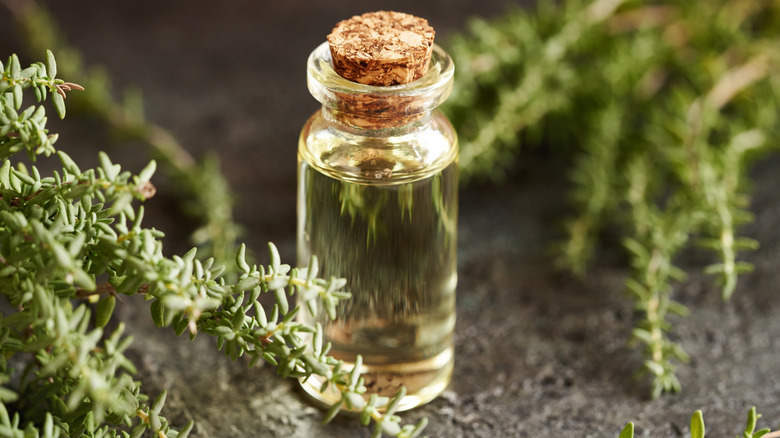Natural Alternatives To Store-Bought Fungicide
We may receive a commission on purchases made from links.
Growing any living plants — whether they're climbers, creepers, herbs, trees, or shrubs — is a science as much as it is an art. Different species have different needs, strengths, and weaknesses, though all plants are susceptible to harmful fungi. According to Michigan State University, around 85% of plant diseases are caused by fungal growths, making it imperative to do all you can to prevent and treat a fungi problem promptly.
Many people default to commercially made fungicides, but before you fall back on a chemical-laden synthetic fungicide, consider natural and organic solutions instead. Using the right organic fungicide makes it possible to target specific fungi and bacteria, and not worry about poisoning crops with toxic chemicals. Many natural fungicide ingredients break down in soil without having any long-term detrimental effects, making them safer than lingering synthetics.
Below are seven fungicide ingredients you can DIY at home to target specific parts of your garden. Learn more about what these ingredients are and what makes them effective for eliminating fungus, while also educating yourself on how to apply them effectively. Essentially, you're able to fight lawn fungus and other fungi with these trusted natural solutions, so you know what you're putting in your soil and how it's affecting your local environment.
Sulfur fights fungal disease by disrupting fungi's metabolic processes
Sulfur is a naturally occurring element that's also one of the most important macronutrients for plants. It helps foliage create the chlorophyll it needs to photosynthesize, making this nutrient vital for plant health and survival. It's an element and active ingredient found in food, plants, soil, and water that kills fungi on contact by disrupting the fungi's metabolic processes and its ability to spread. You can apply sulfur to all types of crops, including fruit and nut trees, berry bushes, vegetable plants, ornamental flowers, and even grasses.
Pre-made sulfur fungicide is purchasable at popular retailers like Lowe's, Tractor Supply, and Walmart. Gardeners can also make their own powder by grinding up a sulfur rock. Purchase a sulfur rock and decimate it using a variety of methods. Try Priority Chef's Heavy Duty Large Mortar and Pestle Set, which comes in three cup sizes, to crush up the rocks. Another method is to place sulfur rocks in a plastic bag and hammer them to create a fine powder. Once the rock is fully crushed, sprinkle it directly over plant leaves and stems, or mix up to 3 tablespoons of sulfur powder for every 1 gallon of water. Put the mixture in a Chapin 20000 1-Gallon Lawn and Garden Pump Pressured Sprayer apply it to the plants. A word of warning: Do not use sulfur on your plants if the temperature is going to reach 85 degrees Fahrenheit or above, as it can burn the plants' leaves. Also, note that sulfur can raise the acidity of the soil, so be aware of what plants you're growing and their soil requirements.
Bordeaux mix combines copper sulfate, lime, and water to manage various fungal diseases
Create a copper sulfate mixture, also known as a Bordeaux mix, with copper sulfate, lime, and water. Copper is another natural resource that effectively prevents fungus. However, it only works if used as a precautionary measure. The ions in copper destroy proteins and enzymes in fungus cells, preventing them from being able to take over a garden. Lime is added to this mix to adjust the copper pH and make the ions more available. Water doesn't affect the pH level of the mix, and is solely used to make it more diluted, depending on how heavy you want the mixture to be. The only downside of Bordeaux mixtures is that using them long-term causes bacteria to build up resistance. They are often used for various issues on fruiting trees, such as fire blight on pears and apples and leaf curl on peaches and nectarines.
Use Alpha Chemicals' Copper Sulfate Pentahydrate and LimeFav's Slaked Lime, or similar ingredients, to craft your mixture. There are many formulas, though the usual ratio is 10 pounds copper to 10 pounds lime to 100 gallons water, but of course you can make a smaller amount. This mixture can be corrosive and dangerous, so exercise extreme caution while creating it. Simplify the process and minimize necessary cleanup by mixing it directly in a garden sprayer, like the one mentioned above. An agitator will make mixing easier, but if you don't have one, you can mix small amounts little by little. Only make as much Bordeaux as you need; it's only good for one use, and you can't store leftovers to use later, as the ingredients deteriorate over time. However, the individual ingredients can be put in dry storage for future mixes.
Baking soda deters powdery mildew during the early stages of growth
Baking soda is a household essential typically used for cooking and cleaning, but this kitchen ingredient also destroys fungus in gardens. Before you begin, there are some things you should know about using baking soda on plants. Sodium bicarbonate is a great alternative to synthetic store-bought fungicides for deterring powdery mildew, as the baking soda alters the pH to make it more alkaline, which is the opposite of what fungi need to germinate. Baking soda treatments aren't as reliable and consistent as more conventional fungicides, so they're often paired with other solutions to increase combined effectiveness. It isn't an aggressive tactic, rather it fights against growth by reducing the acidity of a surface. Since most fungal species thrive in acidic conditions, the neutralization of soil makes it harder for them to grow.
Baking soda, which you can find at most major retailers — such as Amazon Fresh Baking Soda for under $1 — is most effective when paired with a horticultural oil. As mentioned previously, it works best as a preventative measure and when applied to fungi that favor acidic soil, such as powdery mildew. The longer you wait to apply baking soda and the worse the infection gets, the less likely it is to work. Mix about 1.5 tablespoons of baking soda, 3 tablespoons of horticultural oil, and 1 gallon of water, and use this combination to water plants before a fungal infection sets in.
Diluted hydrogen peroxide wipes out fungus growth
In an exclusive House Digest interview with gardening expert Matthew Wilson about things you should never do with hydrogen peroxide (and what you can do instead), he informed us that, "Hydrogen peroxide is very effective in order to treat fungal infections and root rot." Even though hydrogen peroxide is a natural fungicide alternative, it requires careful and selective application. It shouldn't be applied to seedlings and unestablished plants, especially since its effectiveness and risks aren't well-documented in the gardening world. High concentrations of this solution bleach and disinfect surfaces, and hydrogen peroxide has been used to reduce mold spores in food industries, giving it potential in a garden space as well. Not only does it remove mold spores, but it also oxygenates the soil, and helps remove fungal and bacterial growth — although there are much better ways to aerate your soil if necessary.
Keep in mind that hydrogen peroxide doesn't discriminate. It attacks all the bacteria and fungus in your soil, good and bad. It also doesn't keep these organisms from returning, so you'll need to engage in other preventative measures to keep "bad" fungus from coming back to the sterilized soil.
Use a 3% solution of hydrogen peroxide to avoid chemically burning plant leaves and stems, even on fully mature specimens. Mix one part hydrogen peroxide for every four parts water. Pour the water around the base of fully grown plants to remove fungal spores. Although hydrogen peroxide is commonly used when growing fruit trees, it is most effective when used alongside other methods. Don't forget to use other natural fungicides on this list to keep fungi from re-infesting the soil.
Cinnamon leaf essential oil prevents damping-off and powdery mildew in plants
Cinnamon oil is well-known as an insect repellent, but also destroys fungi spores in high concentrations. The cinnamaldehyde and eugenol compounds are phytotoxic and inhibit fungal growth. This makes cinnamon oil usable as a fungicide, but also indicates it's strong enough to be a herbicide (at a rate of 200 g/m2). This active ingredient can be harmful if it directly touches foliage, so it's vital to restrict it to the soil, where it is actually highly useful for the many soil-borne diseases. Fusarium, Pythium, Phytophthora, Rhizoctonia, Verticillium, and nematodes start in soil, making them preventable using this oil concoction.
One thing to keep in mind is that plants can also soak up traces of the cinnamon oil, meaning you should avoid using this method on food crops, which could potentially absorb the phytotoxins into their harvests. Some sources say it's effective when used on fruiting crops, but its risks still need to be studied.
Combine cinnamon leaf oil with a savory kitchen staple to fight fungus — garlic oil is a particularly effective fungicide due to the compound allicin, which has fungal-fighting power. Keep in mind that a low concentration won't have any significant impact. Put one or two drops, or about half a teaspoon, of cinnamon leaf essential oil in about a cup of water. You can also add one or two drops of garlic oil. Pour the mixture around inedible plants, not on top of them.
Milk can deter powdery mildew from taking hold
Gardeners who also raise livestock can rejoice, as milk actually works to treat mildew in your garden. Milk byproducts have been proven to be even more effective than popular chemical fungicides in some case, quickly and thoroughly removing powdery mildew from many studied crops. Since other forms of fungicide create resistance that diminishes their effectiveness over time, milk makes a useful replacement. There have been scientific studies of milk's success for removing on powdery mildew in zucchinis, squash, grapes, other field crops, and flowers like begonias and zinnias. In a study at Harper Adams University College, milk was even better at reducing the rate of disease progression than sulfur products. The reason why this works is because milk contains lactoferrin, a protein that increases iron content to create an anti-microbial effect. Be wary not to use too much milk, since it will spoil and rot in your garden.
Like most natural alternatives to store-bought fungicides, you should dilute milk with water before using it to treat and prevent fungus. Create a diluted mixture of about 40% milk and 60% water and apply it on a weekly basis starting at the beginning of the growing season. It doesn't matter what kind of milk you use — the protein in the milk works against the fungi, not the fat content. Keep in mind that dried skim milk can lead to its own slough of issues; including black and soft rot on some vegetable crops, so it's probably best to go for another option.
Thyme oil is effective for preventing select fungi
Thyme oil operates like most natural and organic fertilizers. They work better for preventative use than for destroying pre-existing fungal growth. The compound causing this anti-fungal effect is thyme's main active ingredient, thymol. Thymol prevents fungal spores from germinating and inhibits cells from growing, but only specific types. Washington State University reports that it reduces up to 25% of black spot fungus and over 70% of powdery mildew growth. This herb oil also works on botrytis, a common fungal infection in grapes.
Thyme oil is easy to apply to plants, and it's even easier to use when the correct concentrations are pre-mixed with a product like Thyme Guard. But, note that even this product — which contains 23% thyme essential oil and 77% alcohol and soap — should be diluted beforehand. Mix no more than 2 quarts of Thyme Guard (or your own DIY version) for every 100 gallons of water, and do not exceed 1 quart per 100 gallons of water if using it on young plants or those with leaf wax layers. Apply this solution to both the foliage and soil.
